Taking and managing restaurant reservations is a multifaceted process that constitutes a critical part of your restaurant’s operations.
It’s not just about providing your guests with the convenience of booking a table but also about maximizing your establishment’s revenue and efficiency.
To help you achieve this aim, this article will serve as a detailed guide to collecting restaurant reservation deposits.
We’ll break down the why and how, examine the pros and cons of this practice, and equip you with the practical knowledge you’ll need in order to implement a reservation deposit system effectively.
Buckle up as we go on a journey to reclaim control and optimize your bookings, starting by elaborating on the benefits of this practice.
Why Should You Take Reservation Deposits
Imagine you had expected a fully packed restaurant, with your waitstaff being at their best and the kitchen fully prepped to dish out culinary masterpieces, only to be met with empty tables.
That is the type of damage no-shows and last-minute cancellations can do to your business.
Such unexpected surprises don't just deflate the atmosphere but also take a toll on your bottom line.
In fact, according to this article, missed reservations can dramatically affect your sales.
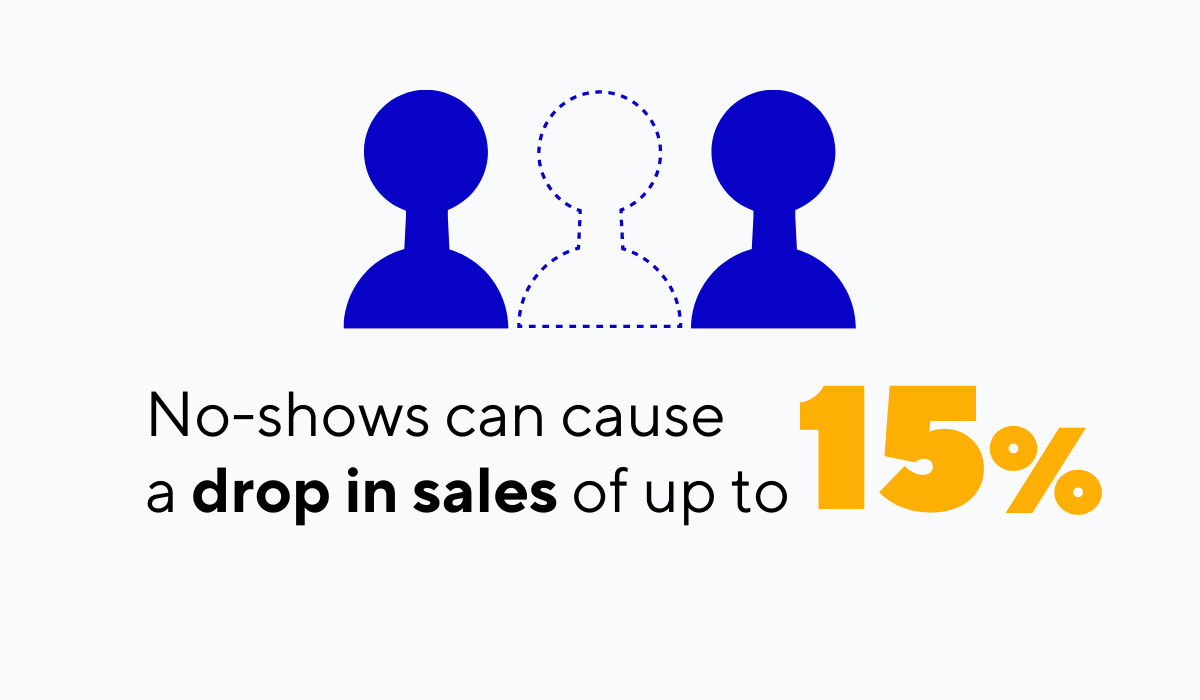
Illustration: Tablein / Data: Restaurant
Say your restaurant typically generated $20,000 on a weekend night.
A 15% decrease would equate to $3,000 or a $12,000 monthly loss if you consider each weekend of the month.
Luckily, one way to mitigate these issues is through the practice of taking restaurant reservation deposits.
When a partial payment has to be made by customers at the time of booking, which is returned or deducted from their final bill, you create a financial commitment, encouraging guests to honor their reservations or cancel within a reasonable time frame.
Consider the experiences of Billy Wagner of Nobelhart & Schmutzig and Bobby Bräuer of Esszimmer.
They shared that no-shows were a significant problem for their businesses, with the amounts they lost each month shown below.
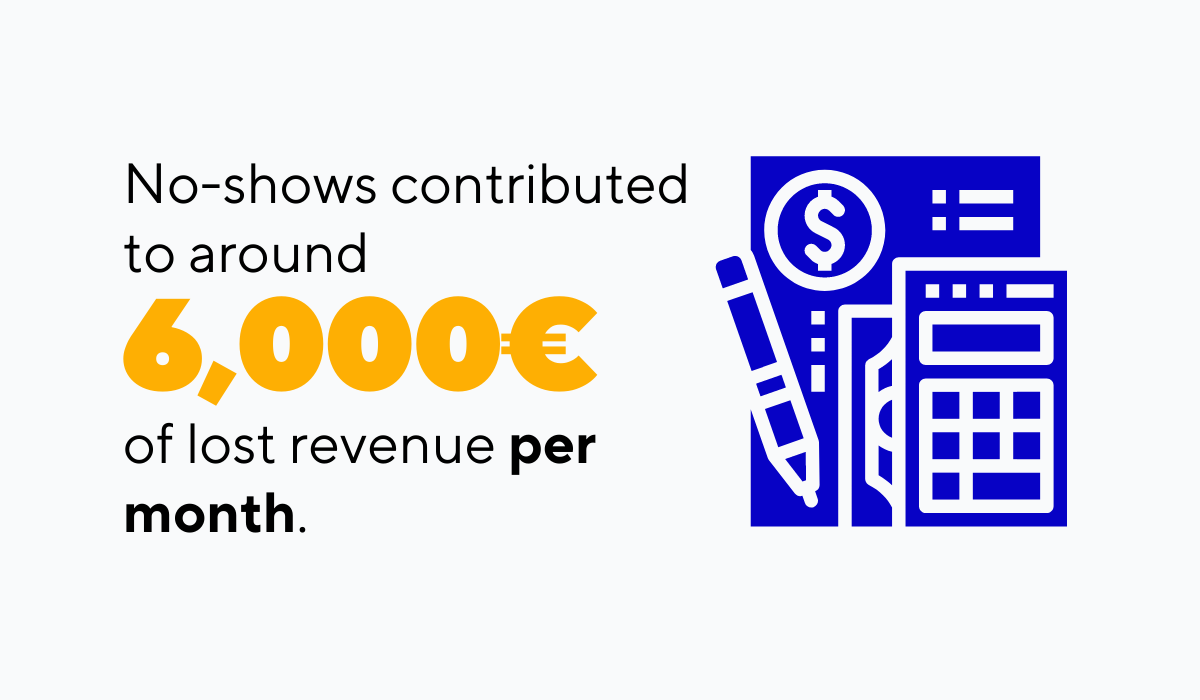
Illustration: Tablein / Data: Aleno
Once they implemented reservation deposits, however, the monthly loss of revenue they experienced was almost entirely eliminated.
The threat of losing the deposit was more than enough to discourage indecisive guests from making a booking and make sure that the guests who do book a table honor their reservation.
As you can see, adding a reservation system can prevent no-shows and add a layer of protection to your profits if they do occur.
What Are the Pros and Cons of Charging Deposits
Before jumping headfirst into charging reservation deposits, weighing the pros and cons is wise.
Like any business decision, implementing a deposit system comes with its own set of advantages and potential drawbacks.
Understanding both sides of the coin will help you craft a policy that suits your restaurant’s needs and keeps your clientele happy.
So, let's dive right in and explore what you stand to gain by covering the pros.
The Pros
Aside from shielding your revenue from no-shows, a reservation deposit system offers multifaceted benefits for your business.
One of the advantages is that it positively impacts the job security of your staff. When reservations are unreliable, staffing becomes a gamble.
You bring in staff based on the number of expected bookings, and when they don’t arrive, it’s the staff that bears the brunt.
Celebrity chef Tom Kerridge perfectly captured this issue, stating the following in an Instagram post:
…we put staff levels to the number of covers booked and when you fail to turn up, it now costs us, which in turn will force very uncomfortable and hard decisions about staffing levels.
Deposits can provide more job security for your employees.
Through this practice, your reservations become more predictable, translating into more stable shifts and pay for your staff.
In the same vein, your kitchen faces similar issues. The chefs prepare ingredients according to the number of reservations.
When reservations go up in smoke, so does the prepared food.
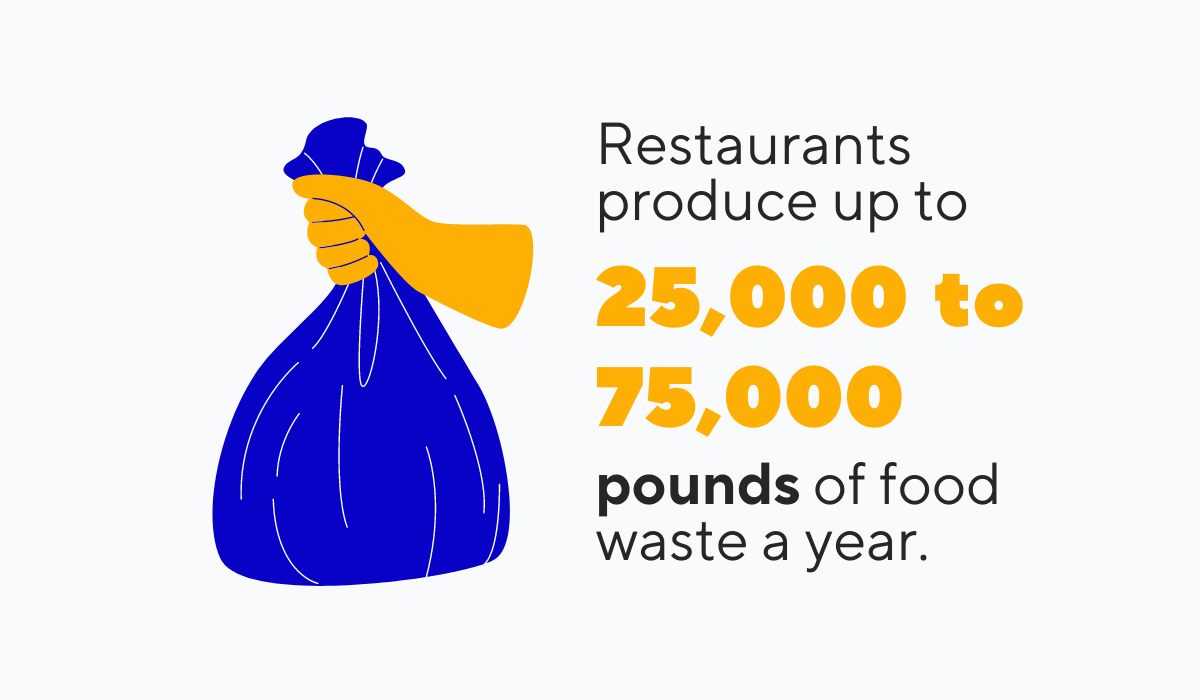
Illustration: Tablein / Data: Fourth
The food that could have gone into splendid meals for your guests turns into waste.
This issue not only results in lost revenue but also adds to the staggering amount of food waste restaurants produce yearly.
Reservation deposits nudge guests to honor their bookings, which means your kitchen can prep confidently and without worry.
The Cons
Let's hit the brakes and talk about the flip side.
Deposits boast benefits for your sales, staff, and resource utilization. Sounds like a dream, right?
But, there's a fundamental part of the equation we've overlooked—your guests.
For many patrons, reservation deposits are a baffling and needless complication.
They wish to make reservations freely, sometimes even at multiple places, without the shackles of accountability.
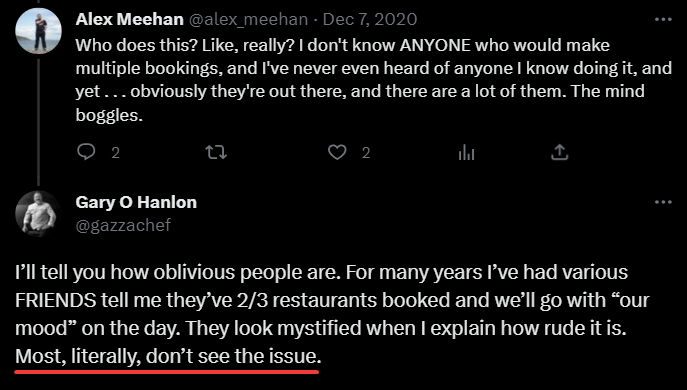
Source: Gary O Hanlon on Twitter
Gary O Hanlon’s tweet above clearly illustrates the issue, stating that some diners fail to comprehend the harm no-shows inflict on eateries.
Consequently, because the notion of being charged for a booking and potentially losing the deposit if they miss a reservation is alien to them, a deposit policy might baffle them.

Source: C2ker1 on Reddit
The comment from the Reddit user above reflects the bewilderment and strong sentiments guests can have toward reservation deposits.
And some of them could potentially be discouraged from making reservations altogether.
Even if they do proceed, your staff might face an onslaught of questions such as:
- Why do I have to pay the deposit?
- Is the deposit refundable?
- What happens if I need to cancel?
The questions will require your staff to spend extra time explaining the policy, which can be tedious for both parties.
By being aware of these potential downsides, you can weigh whether implementing a deposit system aligns with your restaurant's values and clientele.
What Types of Deposits Can You Take
You’ve decided that taking deposits is the right move for your restaurant. But wait, did you know there's more than one type of deposit?
It’s essential to understand the options available to choose what best aligns with your restaurant’s operations and customer expectations.
In the next sections, we will cover two types of deposits: reservation deposits and prepaid reservations.
Reservation Deposits
Reservation deposits are the most straightforward types of deposits you can take. You are most likely already familiar with them.
These deposits are essentially small fees that customers pay to secure a reservation at your restaurant.
This practice ensures that diners are more likely to honor their booking, as they've already invested money or credit in it.
You can decide whether to charge the deposit upfront or simply hold your customer’s card details and charge them if your cancellation policy is broken.
The latter practice is followed by GOAT restaurant, as shown below.

Source: SampleTemplates
As GOAT’s terms and conditions state, customers must leave their card information which is then verified, but nothing is charged unless the customer fails to cancel on time or doesn’t honor their table booking.
If, on the other hand, you decide to collect the reservation deposit upfront, transparency is key in regard to your refund policy and any penalties incurred from late cancellations.

Source: Havana Bar
Havana Bar’s booking policy includes all the necessary information we mentioned, including the cancellation period where a full refund will be granted, the conditions where only 50% is refunded, and the cut-off date where guests aren’t entitled to a refund.
All in all, a reservation policy provides a safety net for your revenue and ensures late cancellations and no-shows don’t hurt your business so much if they do occur.
Prepaid Reservations
An entirely different way of taking deposits is to have prepaid reservations.
As the name suggests, this practice includes guests paying for their entire meal at the moment they make their reservation. It’s not just a deposit but a full payment.
Now, you might wonder why a restaurant would opt for this policy, given that even regular deposits can deter some guests from booking a table.
Well, prepaid reservations come in super handy, especially when you have the following two types of menus:
In these cases, the restaurant needs to accurately predict the cost and the amount of food needed, helping reduce wasted resources and ensuring that the restaurant can efficiently cater to the special menu without incurring losses from potential missed bookings.
To illustrate, take a gander at this special chef tasting menu.

Source: 333 Pacific
This menu from 333 Pacific, priced at $37 per person and including three special courses, likely needs to be paid for upfront, right when guests reserve a table.
The reason? The restaurant needs to secure and prep the high-quality ingredients for these exclusive dishes, and knowing the exact headcount minimizes all risks.
So, prepaid reservations are a more secure option for your restaurant that gives you control over your reservations, but it is a practice that should be saved for special events or offers.
How to Take Reservation Deposits at Your Restaurant
Now that you're familiar with the types of deposits, it’s time to roll up your sleeves and work on setting up your own reservation deposit system.
From the technical setup to communicating the policy effectively, there are a few vital steps you'll need to take, which we will cover next.
Set Up Your Restaurant Reservation Software
To ensure you set up and enforce your deposit policies most effectively, you should consider using restaurant reservation software.
While you may certainly take deposits without such a system, you can read the case study of Sip Café, which had firsthand experience of the pitfalls of not using reservation software.
They initially required customers to visit their cafe to make a deposit physically. They had the following to say about their practice:
At times it was extremely difficult for the clients to make a special journey to our café, only to leave the deposit. This was especially awkward if the guests lived on the outskirts of town.
Fortunately, Sip Café made the wise choice to switch to Tablein, our restaurant reservation software.
It’s a system loaded with features that are easy to understand, so it makes the process of taking deposits ridiculously simple.
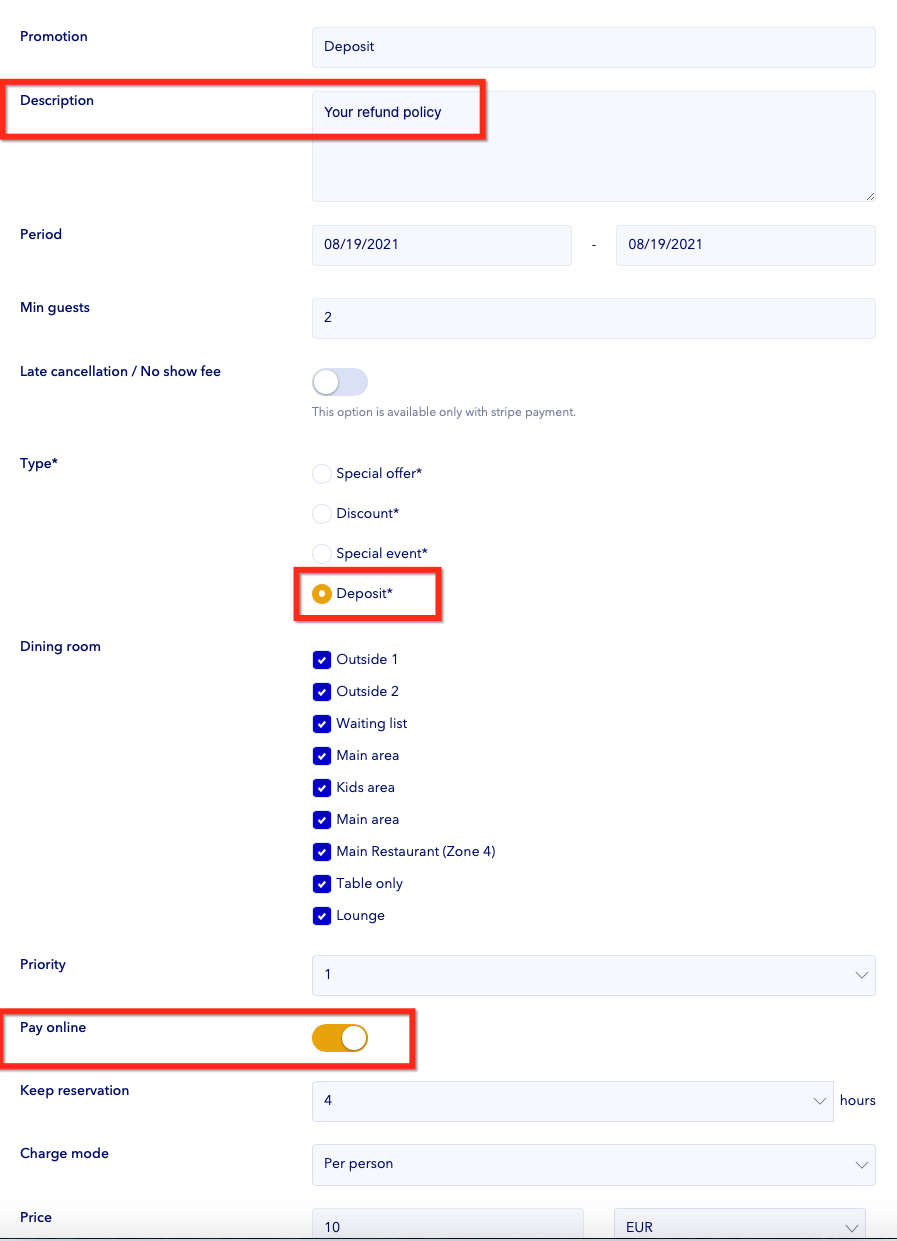
Source: Tablein
Whether you want to take a reservation deposit or set up prepaid reservations the process of setting up Tablein includes just checking a few boxes that concern the details of your deposit policy.
You set the deposit amount, select which dining areas require deposits, and you’re good to go.
Tablein can quickly become a valuable resource for your restaurant, not just for taking deposits but as an all-in-one reservation management system.
Decide When and How You Want to Take Deposits
While you are crafting your deposit policy, you should decide on the specifics of when and how you will take the deposits.
It’s crucial to understand that taking deposits isn’t a one-size-fits-all system. You've got the liberty to tailor a policy that resonates with your restaurant’s dynamics.
For instance, maybe you’re fine with not taking deposits generally but want to ensure a commitment to your more exclusive offerings.
To illustrate, check out the policy of the restaurant and game venue Bounce displayed next.
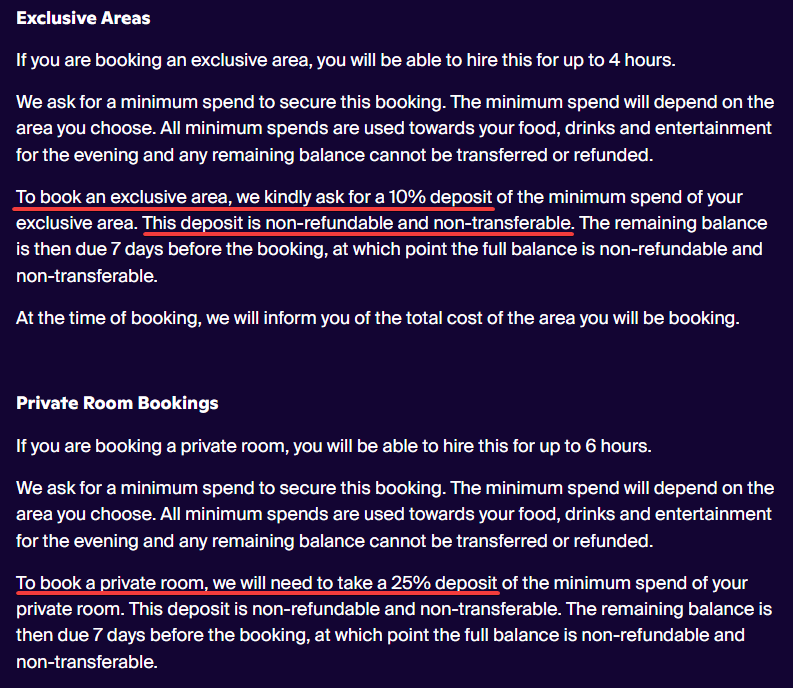
Source: Bounce
As you can see, Bounce charges specific deposit amounts for their exclusive areas and for private room bookings.
This specific policy works as it protects their high-demand spaces from being reserved by uncommitted customers. Plus, it further expands on the exclusivity of these offers.
You've also got options when it comes to the deposit amount.
The example above uses a percentage deposit calculated from the required minimum spend at their restaurant.
But you can just as well choose to go with a flat fee deposit policy.
The latter is more straightforward and simple for customers to understand, while a percentage option can be the more flexible option.
Overall, by shaping your deposit policy to fit your restaurant's operations, you're setting up a smoother and more effective system.
Be Open and Clear About Your Deposit Policy
Whatever policy you craft, it’s imperative that it's transparent and easily accessible to customers.
What does this mean? Simply that your booking policy needs to be clearly displayed, ensuring that guests are well-informed before making a reservation.
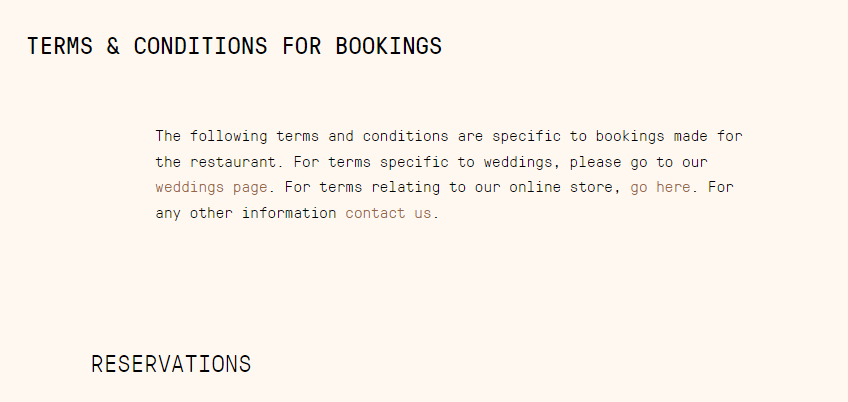
Source: Zonzo
Take, for example, Zonzo. They have included their comprehensive policy on their website.
This is crucial as it helps customers understand what is expected of them and avoids any confusion or misunderstandings that can lead to customers canceling their reservations out of frustration.
While having a detailed policy on your website is great, you should also ensure that it’s easily accessible.
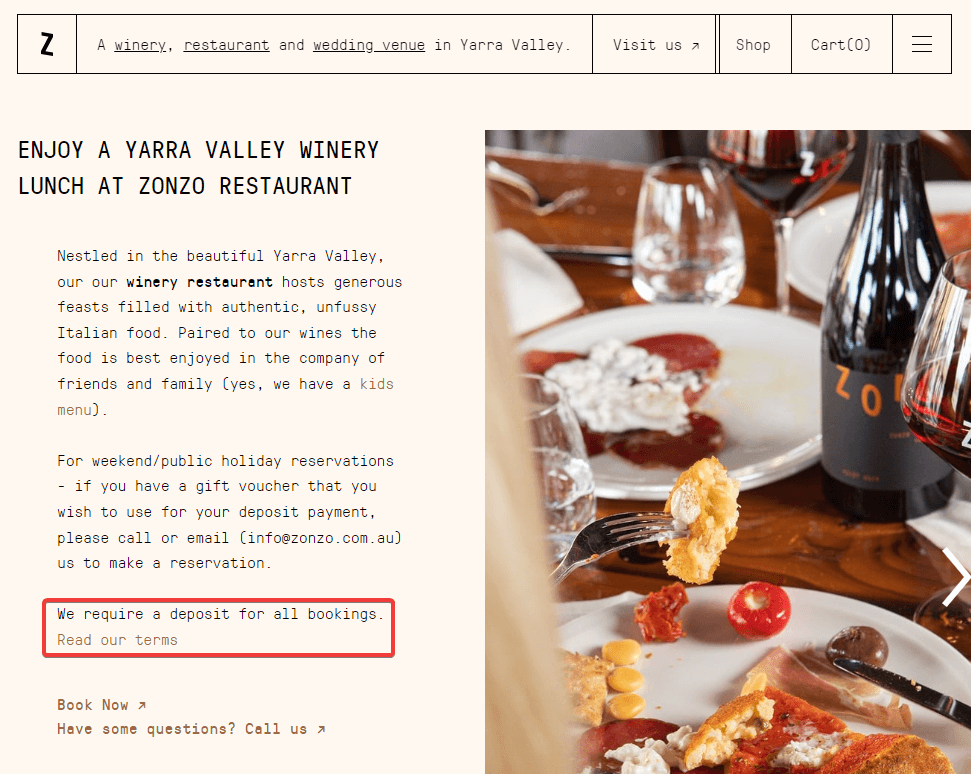
Source: Zonzo
Zonzo’s policy is somewhat hidden.
You can reach their policy through only a small text link that can be easily missed amidst the rest of the text and attention-grabbing images on the page.
To remedy this problem, you can include a more concise version of your booking policy on your reservation widget’s screen.
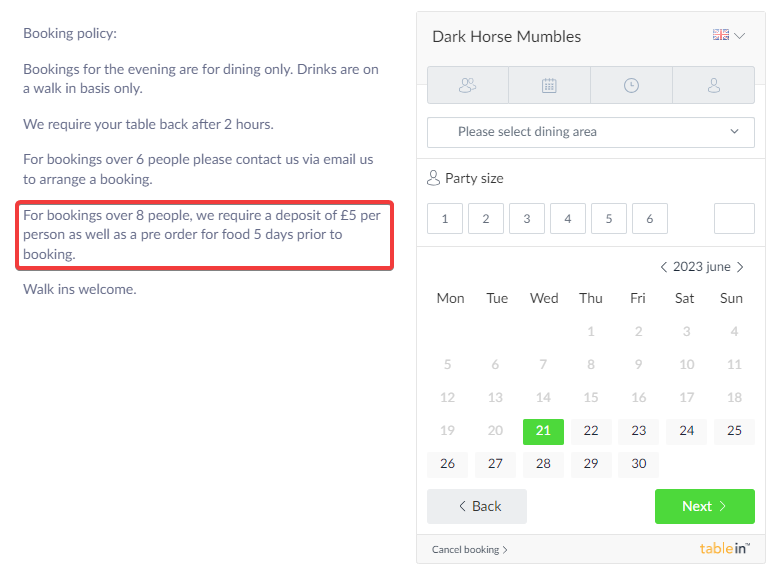
Source: Tablein
This version of the policy should summarize its key points, including the details about the deposits that are required.
This practice makes it convenient for the customers as they can see the essential information right where they are making the booking.
To conclude, making the booking and deposit policy readily available is vital for a smooth and stress-free reservation experience for your customers.
Conclusion
In this comprehensive article, we’ve provided you with a detailed overview of reservation deposits, exploring all the crucial aspects of this practice.
Together, we’ve navigated through the advantages and drawbacks of adopting a deposit system, highlighted the different types of deposits available, and examined some hands-on advice to help you get started.
We hope this information has broadened your understanding of deposits and given you the confidence to make well-informed decisions in creating your own deposit policy.
Equipped with this knowledge, you can implement a transparent, fair, and profitable system.
Ultimately, by safeguarding your revenue and building trust with your patrons, you're steering your restaurant into calmer waters.
Get a 30-day Exclusive Trial
As a Tablein blog reader, you’re eligible for an exclusive 30-day free trial to experience our simple reservation solution for your restaurant.
Enter your business email, and we’ll send you all the steps needed to create your account.
Share this
You may also like

6 Biggest Benefits of Restaurant Reservation Confirmation Emails

5 Benefits of an Online Reservation System for Restaurants
